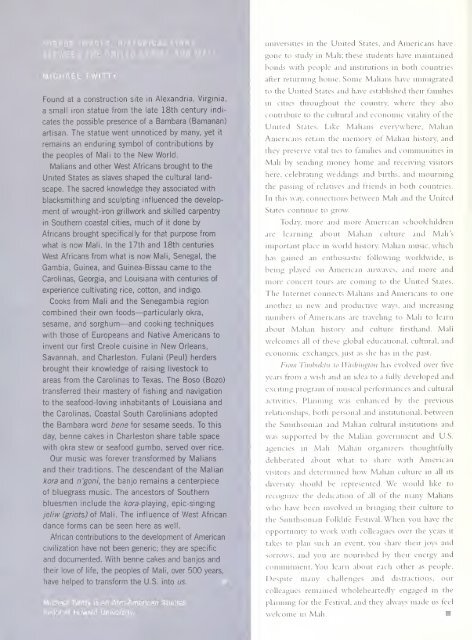SCOTLAND - Smithsonian Digital Repository - Smithsonian Institution
SCOTLAND - Smithsonian Digital Repository - Smithsonian Institution
SCOTLAND - Smithsonian Digital Repository - Smithsonian Institution
Create successful ePaper yourself
Turn your PDF publications into a flip-book with our unique Google optimized e-Paper software.
universities in the United States, and Americans have<br />
gone to study in Mali; these students have maintained<br />
bonds with people and institutions m both countries<br />
after returning home. Some Malians have immigrated<br />
Found at a construction site in Alexandria, Virginia,<br />
a small iron statue from the late 18th century indicates<br />
the possible presence of a Bambara (Bamanan)<br />
artisan. The statue went unnoticed by many, yet it<br />
remains an enduring symbol of contributions by<br />
the peoples of Mali to the New World.<br />
Malians and other West Africans brought to the<br />
United States as slaves shaped the cultural landscape.<br />
The sacred knowledge they associated with<br />
blacksmithing and sculpting influenced the development<br />
of wrought-iron grillwork and skilled carpentry<br />
in Southern coastal cities, much of it done by<br />
Africans brought specifically for that purpose from<br />
what is now Mali. In the 17th and 18th centuries<br />
West Africans from what is now Mali, Senegal, the<br />
Gambia, Guinea, and Guinea-Bissau came to the<br />
Carolinas, Georgia, and Louisiana with centuries of<br />
experience cultivating rice, cotton, and indigo.<br />
Cooks from Mali and the Senegambia region<br />
combined their own foods — particularly okra,<br />
sesame, and sorghum—and cooking techniques<br />
with those of Europeans and Native Americans to<br />
invent our first Creole cuisine in New Orleans,<br />
Savannah, and Charleston. Fulani (Peul) herders<br />
brought their knowledge of raising livestock to<br />
areas from the Carolinas to Texas. The Boso (Bozo)<br />
transferred their mastery of fishing and navigation<br />
to the seafood-loving inhabitants of Louisiana and<br />
the Carolinas. Coastal South Carolinians adopted<br />
the Bambara word bene for sesame seeds. To this<br />
day, benne cakes in Charleston share table space<br />
with okra stew or seafood gumbo, served over rice.<br />
Our music was forever transformed by Malians<br />
and their traditions. The descendant of the Malian<br />
kora and n'goni, the banjo remains a centerpiece<br />
of bluegrass music. The ancestors of Southern<br />
bluesmen include the /(ora- playing, epic-singing<br />
jeliw (griots) of Mali. The influence of West African<br />
dance forms can be seen here as well.<br />
African contributions to the development of American<br />
civilization have not been generic; they are specific<br />
and documented. With benne cakes and banjos and<br />
their love of life, the peoples of Mali, over 500 years,<br />
have helped to transform the U.S. into us.<br />
to the United States and have established their families<br />
ill cities throughout the country, where they also<br />
contribute to the cultural and economic vitality of the<br />
United States. Like Malians everywhere, Malian<br />
Americans retain the memory of Malian history, and<br />
they preserve vital ties to families and communities in<br />
Mall by sending money home and receiving visitors<br />
here, celebrating weddings and births, and mourning<br />
the passing of relatives and friends in both countries.<br />
In this way, connections between Mali and the United<br />
States continue to grow.<br />
Today, more and more American schoolchildren<br />
are learning about Malian culture and Mali's<br />
important place in world history. Malian music, which<br />
has gained an enthusiastic tbllowmg worldwide, is<br />
being played on American airwaves, and more and<br />
more concert tours are coming to the United States.<br />
The Internet connects Mahans and Americans to one<br />
another in new and productive ways, and increasing<br />
numbers of Americans are traveling to Mali to learn<br />
about Malian history and culture firsthand. Mali<br />
welcomes all of these global educational, cultural, and<br />
economic exchanges, just as she has in the past.<br />
From Timbuktu to lihsliiugton has evolved over five<br />
years from a wish and an idea to a fully developed and<br />
exciting program of musical performances and cultural<br />
activities. Planning was enhanced by the previous<br />
relationships, both personal and institutional, between<br />
the <strong>Smithsonian</strong> and Malian cultural institutions and<br />
was supported by the Malian government and U.S.<br />
agencies in Mali. Malian organizers thoughtfully<br />
deliberated about what to share with American<br />
visitors and determined how Malian culture in all<br />
diversity should be represented. We would like to<br />
recognize the dedication of all of the many Malians<br />
who have been involved in bringing their culture to<br />
the <strong>Smithsonian</strong> Folklife<br />
its<br />
Festival. When you have the<br />
opportunity to work with colleagues over the years it<br />
takes to plan such an event, you share their joys and<br />
sorrows, and you are nourished by their energy and<br />
commitment. You learn about each other as people.<br />
Despite many challenges and distractions, our<br />
colleagues remained wholeheartedly engaged in the<br />
planning for the Festival, and they always made us feel<br />
major at Howard University.<br />
welcome in Mali.
















